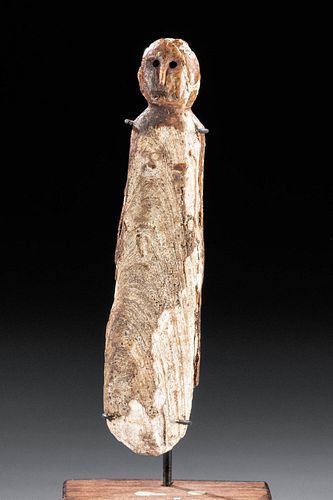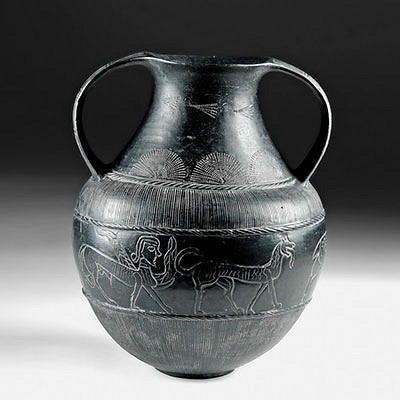Ancient Inupiat Thule Fossilized Tusk Idol / Doll
Lot 109b
About Seller
Artemis Fine Arts
686 S Taylor Ave, Ste 106
Louisville, CO 80027
United States
Selling antiquities, ancient and ethnographic art online since 1993, Artemis Gallery specializes in Classical Antiquities (Egyptian, Greek, Roman, Near Eastern), Asian, Pre-Columbian, African / Tribal / Oceanographic art. Our extensive inventory includes pottery, stone, metal, wood, glass and textil...Read more
Estimate:
$2,400 - $3,600
Absentee vs Live bid
Two ways to bid:
- Leave a max absentee bid and the platform will bid on your behalf up to your maximum bid during the live auction.
- Bid live during the auction and your bids will be submitted real-time to the auctioneer.
Bid Increments
| Price | Bid Increment |
|---|---|
| $0 | $25 |
| $300 | $50 |
| $1,000 | $100 |
| $2,000 | $250 |
| $5,000 | $500 |
| $10,000 | $1,000 |
| $20,000 | $2,500 |
| $50,000 | $5,000 |
| $100,000 | $10,000 |
| $200,000 | $20,000 |
About Auction
By Artemis Fine Arts
Sep 17, 2020
Set Reminder
2020-09-17 10:00:00
2020-09-17 10:00:00
America/New_York
Bidsquare
Bidsquare : CLEARANCE - Ancient, Pre-Columbian, Ethno Art
https://www.bidsquare.com/auctions/artemis-gallery/clearance---ancient-pre-columbian-ethno-art-5605
End-of-Summer Clearance sale featuring discounted pricing on antiquities from Egypt, Greece, Italy, and the Near East...plus Viking, Asian, Pre-Columbian, Tribal, Russian Icons, Spanish Colonial, Fine Art, more! Starting prices have been reduced up to 65% from original auction prices. Artemis Fine Arts info@artemisgallery.com
End-of-Summer Clearance sale featuring discounted pricing on antiquities from Egypt, Greece, Italy, and the Near East...plus Viking, Asian, Pre-Columbian, Tribal, Russian Icons, Spanish Colonial, Fine Art, more! Starting prices have been reduced up to 65% from original auction prices. Artemis Fine Arts info@artemisgallery.com
- Lot Description
**Originally Listed At $1200**
Native American, Northwest Alaska, Brevig Mission, Inupiat culture, Thule Period, ca. 1200 to 1700 CE. An incredibly rare effigy idol of a petite size, hand-carved from the fossilized tusk of a walrus. The figure, which has been long preserved in the frozen earth of northern Alaska, has an elongated lower body and a miniscule spherical head with impressed eyes. a narrow nose, and a thin mouth. The wonderful state of preservation of this figure is accentuated by the smooth patina that has formed across the exterior. A fabulous example from the ancient Inupiat! Size: 0.625" W x 2.875" H (1.6 cm x 7.3 cm); 5.1" H (13 cm) on included custom stand.
The Inupiat people were the ancestors of modern Inuit whose advanced culture and technology made them a part of the global economy during what we in the West call the Medieval period. This figure was carved during a dynamic time in Inupiat history during the Thule period; recent research indicates that sometime after ca. 1200 CE, perhaps in a span of just a few years, the Inupiat and Thule peoples spread from their Bering Strait homelands all the way to Greenland, likely driven by the search for iron, both from meteoric deposits they may have heard about from the Dorset people to their east and from trade. They traded with the Chinese to their west - metal beads and a belt buckle of Chinese manufacture and dating to 1100 to 1300 CE have been found in in the Seward Peninsula - and interacted with the Vikings to their east, who describe them in the Vinland Saga as the Skraelings.
Provenance: private Newport Beach, California, USA collection, found in village of Brevig Mission, Alaska
All items legal to buy/sell under U.S. Statute covering cultural patrimony Code 2600, CHAPTER 14, and are guaranteed to be as described or your money back.
A Certificate of Authenticity will accompany all winning bids.
We ship worldwide and handle all shipping in-house for your convenience.
#148577Minor nicks and abrasions to body and head, with light softening to some finer details, otherwise intact and very good. Light earthen deposits and fine patina throughout.Condition
- Shipping Info
-
All shipping is handled in-house for your convenience. Your invoice from Artemis Gallery will include shipping calculation instructions. If in doubt, please inquire BEFORE bidding for estimated shipping costs for individual items.
-
- Buyer's Premium



 EUR
EUR CAD
CAD AUD
AUD GBP
GBP MXN
MXN HKD
HKD CNY
CNY MYR
MYR SEK
SEK SGD
SGD CHF
CHF THB
THB














